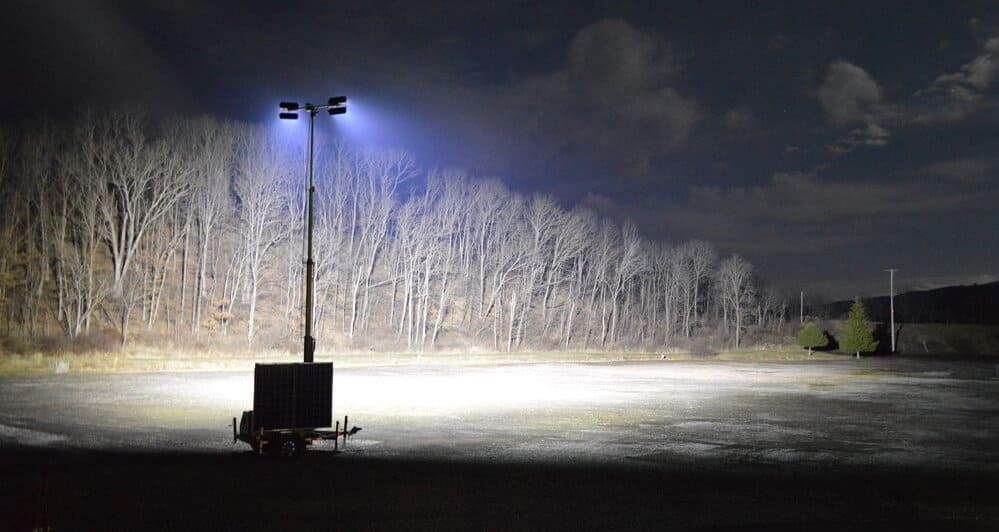Lighting remote sites is a real headache—especially when there's no power grid, constant fuel needs, or people to maintain it.
Solar-powered light towers1 are the best choice for remote sites because they need no fuel, little to no maintenance, and can run automatically without daily oversight.

Sometimes, the job site is just too far out. Maybe it’s a desert. Maybe it’s deep in the mountains. Either way, sending someone out every day just to refuel or fix a light tower wastes time and money. That’s where solar-powered lighting wins—no cords, no refueling, and nothing to break down fast.
What Makes Solar Light Towers Ideal for Maintenance-Free Operation?
Even the most durable diesel-powered lights need checking. But what if you didn't have to check at all?
Solar-powered light towers1 have no engine, no oil, and no fuel tank—this means fewer moving parts and fewer chances to fail.

When we remove engines and fuel, we remove maintenance. There’s no oil to change. No fuel to top off. And no engine parts to wear out. Solar light towers run off the sun and store energy in batteries. The LED lights2 last for years, and the batteries can power them all night. Most towers also have smart controllers3 that turn the lights on and off based on sunset and sunrise. So the whole system runs itself, with no need for daily attention.
Why is Solar Lighting a Better Fit for Remote Environments?
| Feature | Diesel Light Towers | Solar-Powered Light Towers |
|---|---|---|
| Fuel required | Yes | No |
| Maintenance frequency | Weekly or bi-weekly | Rare (battery check only) |
| Emissions | High (CO₂, NOx, noise) | Zero |
| Startup time | Manual | Auto (sunset sensor) |
| Cost over time | High (fuel + service) | Low (free energy + fewer parts) |
| Environmental impact | High | Low |
Many job sites are several hours away. It’s not practical to visit every day. With solar, once the tower is in place, it can operate for weeks or months without a technician visiting. This matters for off-grid construction, mining, emergency operations, or security sites in remote areas. The energy from the sun is stored in deep-cycle batteries4, and quality systems can run 3–5 days even with bad weather.
How Long Do Solar Light Towers Actually Last?
People ask if solar is reliable. The answer is: yes, and then some.
Solar-powered light towers1 can run for years with only minor maintenance, like checking batteries every 6–12 months.

LED lights2 in these towers often last over 50,000 hours. That’s more than 5 years if you run them every night. The solar panels5 don’t wear out quickly, and good batteries can last 3–5 years depending on how often they cycle. Plus, since there are no vibrations or moving engine parts, there’s less wear-and-tear overall. In my experience, some of our units installed for security in rural areas have been operating for over three years without a single on-site repair.
What About Cloudy Days or Long Nights?
Solar is great—but does it work when the sun disappears?
| Condition | Solar Light Tower Behavior |
|---|---|
| Sunny day | Charges batteries fully |
| Cloudy day | Slower charge, runs on stored energy |
| Multiple cloudy days | Most units store 3–5 days’ worth of power |
| Long winter nights | Smart systems reduce brightness to save power |
| Snow-covered panels | Panels at angle to shed snow automatically |
Even in winter or in cloudy regions, solar towers perform well. The secret lies in battery sizing and smart lighting controls. A well-designed tower doesn’t just shut off when it’s cloudy. It conserves energy. Some models use motion sensors to dim lights when no one is around. Others optimize output to stretch battery life. And because these towers are tilted, snow slides off easily, so the panels stay clean and keep charging.
Why Are Solar Towers More Than Just "Green"?
People often choose solar because it’s good for the planet. But it’s also good for the bottom line.
Solar towers save money on fuel, labor, and long-term upkeep—while giving consistent, reliable light in hard-to-reach places.

When you factor in the total cost of ownership6, solar usually wins. Diesel light towers may be cheaper upfront, but they demand constant refueling and repairs. Over months or years, the cost of fuel and service stacks up. Not to mention emissions7 and noise, which are problems in quiet zones or protected environments. Solar towers solve all that. They're quiet, clean, and pay for themselves faster than most expect—especially on sites where access is difficult or fuel delivery8 is expensive.
So, Is There Any Downside?
No product is perfect—but solar light towers come close.
| Pros | Cons |
|---|---|
| No fuel or emissions7 | Higher initial cost |
| Maintenance-free operation | Depends on sunlight availability |
| Long lifespan | Lower brightness in some models |
| Silent and eco-friendly | May require larger space to deploy |
| Smart automation | Battery replacement every few years |
Solar light towers are not for every situation. If you're in a dark warehouse or a shaded urban canyon, traditional power may still work better. But for wide-open, sun-rich sites with little access and a long time frame, solar becomes the clear winner.
Conclusion
Solar-powered light towers1 offer a quiet, clean, and truly maintenance-free solution for lighting remote or hard-to-reach sites.
-
Explore the advantages of solar-powered light towers for remote sites, including cost savings and environmental benefits. ↩ ↩ ↩ ↩
-
Discover the longevity and efficiency of LED lights in solar-powered systems, ensuring reliable lighting. ↩ ↩
-
Find out how smart controllers optimize energy use in solar light towers for efficient operation. ↩
-
Understand the role of deep-cycle batteries in solar light towers and their importance for energy storage. ↩
-
Learn about the benefits of solar panels in lighting systems, including efficiency and sustainability. ↩
-
Analyze the total cost of ownership for solar light towers versus diesel, revealing long-term savings. ↩
-
Compare the emissions from diesel light towers with solar options to see the environmental benefits. ↩ ↩
-
Understand the challenges of fuel delivery to remote sites and how solar solutions can alleviate them. ↩




